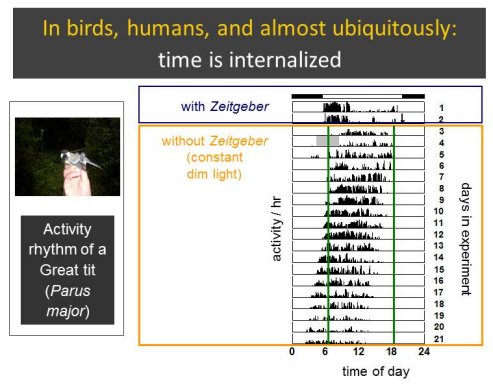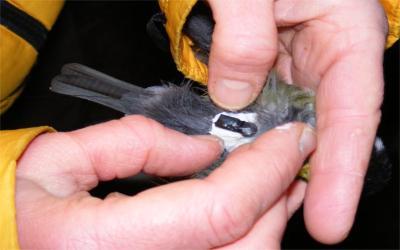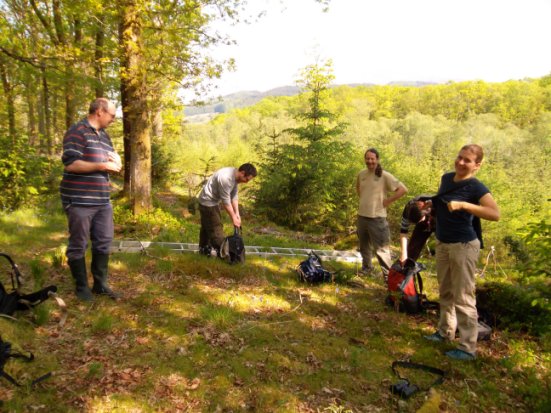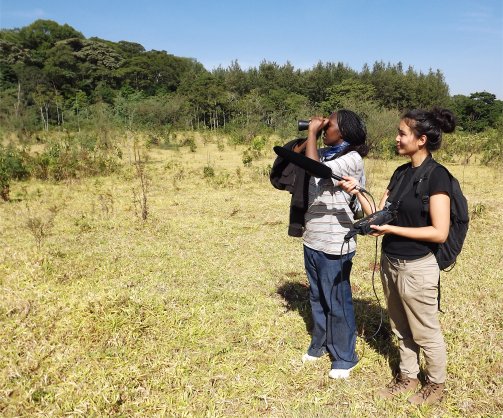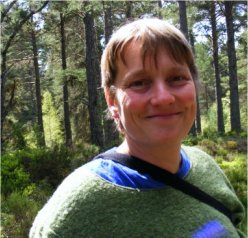Dr Barbara Helm
- Visiting Professor (School of Biodiversity, One Health & Veterinary Medicine)
Biography
- MA (Diplom) Biology, University of Tuebingen, Germany (1997); MA Philosophy, University of Tuebingen (1997)
- PhD Biology, Ludwig-Maximilians-University, Munich, Germany (2003)
Further functions:
- President (August 2013), European Ornithologists' Union
- Deputy director, SCENE field station
Contact details:
Institute of Biodiversity, Animal Health and Comparative Medicine
Graham Kerr Building & Jarrett Building, Garscube Estate
University of Glasgow
UK - Glasgow G12 8QQ
Tel: +44 (0)141 330 2797 (Graham Kerr), 330 5794 (Garscube)
Research interests
Research interests: Chronobiology, ornithology, migration
BIOLOGICAL CLOCKS
Living organisms are exposed to predictable, periodic change in their environments. Keeping track of and anticipating these fluctuations is often highly relevant for well-being, reproduction and survival. Chronobiology, the study of adaptations to cope with geophysical cycles, has revealed an almost ubiquitous presence of endogenous biological clocks that help organisms keep pace with periodic change. Research on biological rhythms has been hugely successful over the last decades and is rapidly gaining importance in many fields. "Time Research" is one of seven identified fields of prospective key importance for scientific and technological development, according to a recent "Foresight" study. However, in contrast to a progressively more detailed understanding of molecular mechanisms, we know surprising little about the functioning and relevance of biological clocks in "the real world" (Michael Menaker). Together with colleagues and students, we aim at integrating the great knowledge base derived from lab-based research with whole-organism studies under natural conditions. We pursue this goal by studying circadian and daily rhythms, as well as circannual and seasonal cycles. We are also interested in life-histories and physiological traits that relate to seasonality, and in particular in annual migration. I’m widely interested in clocks of all organisms but my own research focuses on biological time-keeping in birds.
Clocks, calendars and life-histories of birds:
The early bird catches the worm? Circadian clock and chronotype
Studies of birds have been key for advances in various fields of biology, including chronobiology. Being conspicuous by sight and sound, birds have been closely investigated, and extense life-history information is available. This background is an asset for the interpretation of novel findings and makes them ideal for establishing links between physiology and ecology. For chronobiology, birds are particularly interesting subjects because their outstanding mobility implies a need for sophisticated and robust internal time-keeping, for example during long-distance migration to remote target areas. Annual and daily schedules of birds are readily observed and experimentally tested, and can be related to the context of avian ecology and evolution.
Circadian clocks appear to be ubiquitous, but surprisingly, clock traits show substantial, and partly heritable, differences between individuals. Humans can be classified into "chronotypes" that differ consistently in timing of activity, sleep and physiology in their regular lives. If sheltered from information about the time of day, early chronotypes tend to have faster endogenous, circadian clocks than do late chronotypes. We study birds towards a better understanding of the diversity of clock traits, its origin and its implications. What are the benefits and costs of being an early or late chronotype, and what are the physiological correlates? Under natural conditions, how does chronotype relate to the underlying circadian clock? These questions can be addressed by complementary studies in the wild, in captivity, and by molecular in-vitro techniques. We currently look at daily patterns of activity and body temperature, at possible modification of clocks in urban environments, and at circadian cycles in cell culture.
Circadian activity of a Great tit recorded for three weeks in captivity. The actogram shows that daily activity (shown by black bars) "free-runs" (i.e. drifts from time of day) in birds that receive no information about external time.
Great tit equipped with a light-weight, glued-on transmitter prior to release back into the wild.
Sexual selection on circadian clocks?
In two recent studies with Marcel Visser (Wageningen, The Netherlands), we were able to demonstrate that the circadian clocks that underlie daily activity are highly repeatable and heritable in Great tits (Parus major). Siblings were relatively similar to each other in circadian period length. Moreover, we found that differences in the speed of the clock were related to paternity: nestlings sired by extra-pair fathers had significantly faster clocks than did their half-siblings sired by within-pair fathers. Although still based on a small dataset, this finding suggests that circadian clocks, or traits that are influenced by them, are under sexual selection.
For details, see
- Helm, B. & Visser, M. 2010. Heritable circadian period length in a wild bird population. Proceedings of the Royal Society of London Series B, 277, 3335-3342.
- Lehmann, M., Spoelstra, K., Visser, M. & Helm, B. 2012. Effects of temperature on circadian clock and chronotype: an experimental study in a passerine bird. Chronobiology International, 8, 1062-71.
Daily patterns of activity and body temperature:
To understand how clocks affect fitness and how circadian rhythms are balanced by behavioural flexibility, birds need to be monitored around the clock in their natural habitats. This is now possible thanks to newly developed remote tracking techniques. We apply these methods and establish markers that best characterize the chronotype of a bird. Among traits that can be remotely measured, the daily cycle in body temperature may be particularly telling of internal time-keeping. We recently used a number of different methods to record body temperature in relation to daily activity.
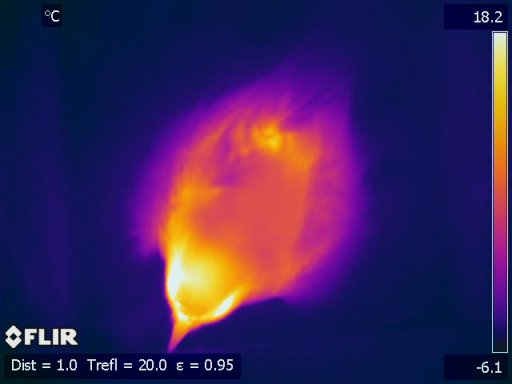
Thermal image of captive Great tit equipped with a glued-on transmitter in winter;
image:
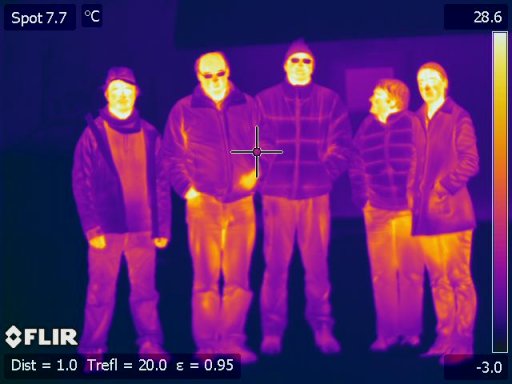
Thermal imaging excursion to Sweden for fieldwork, team picture;
image:
Funding
- Approaching clocks in the real world, Young Scholar Grant, DFG (German Research Foundation) and Konstanz University, 2010-12
- ERASMUS training grant
Field studies of daily rhythms:
We take these methods to the field and study wild Great tits at the University of Glasgow’s brilliantly located field station on Loch Lomond. This research is done collaboratively with , Ross MacLeod and . We use SCENE's surrounding woodlands to investigate benefits and costs of being an early or late chronotype, and its possible behavioural and physiological correlates. A recent study is, Paul Jerem's project 'Does the early subordinate catch the worm?', has established telemetry on wild Great tits. In it, Paul examined consistent time patterns of individual Great tits and the possible relationships between circadian rhythm and social dominance.
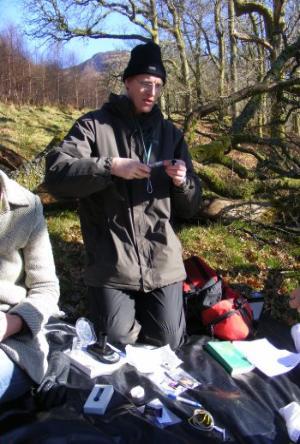 |
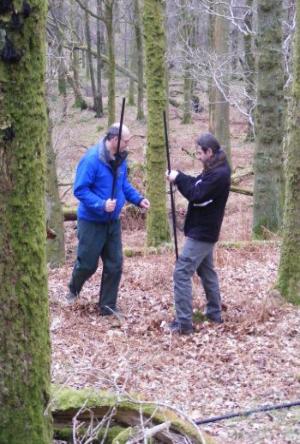 |
| Ross MacLeod ringing a Great tit near | Ruedi Nager and Stewart White setting up nets for ringing near |
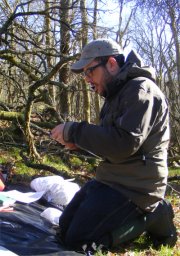 |
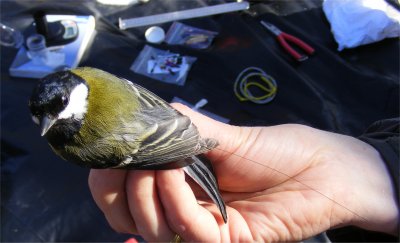 |
| Paul Jerem in the field | Great tit carrying radiotransmitter near |
Funding
- BBSRC doctoral training programme studentship to Paul Jerem.
Clocks in the city:
If circadian clocks are adaptively involved in the regulation of daily behaviour, we expect them to be modified in habitats that are greatly altered by human activity. This is currently investigated by collaborational studies on effects of city life on European blackbirds (Turdus merula) together with Davide Dominoni and Jesko Partecke at the Max Planck Institute of Ornithology in Radolfzell, Germany. We examined whether European Blackbirds which have colonized urban habitats, have changed their behaviour, and if so, whether these changes can be tracked to their biological rhythms. We addressed this question by first comparing activity timing of free-living city Blackbirds to those of wild forest conspecifics, using radio-telemetry. We then recorded activity of the same individuals under constant laboratory conditions to measure their circadian rhythms. City birds started their activity earlier in the wild and had faster but less robust circadian clocks than their forest conspecifics. These findings indicate a link between city life and circadian physiology, and highlight that urbanization may modify biologically important rhythms of life, at least in songbirds.
For details, see
- Dominoni, D., Helm, B., Lehmann, M., Dowse, H.B, & Partecke, J. 2013. Clocks for the city: circadian differences between forest and city songbirds. Proceedings of the Royal Society of London Series B, in press.
Funding
- Volkswagen grant to Jesko Partecke, Radolfzell, Germany
- ERASMUS mobility grant to Davide Dominoni, Radolfzell, Germany
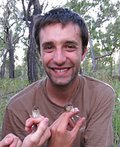 Davide Dominoni
Davide Dominoni
From Field to Molecular Rhythms in Wild Birds:
New tools from molecular biology allow the linking of chronotype to physiological and molecular mechanisms in some species. In her PhD project at the University of Konstanz, Marina Lehmann currently adapts a human protocol to birds. The method measures circadian rhythms in vitro in cells. Therefore, animals would need to be retained only briefly for sampling and could then be released back into the wild. This is a collaborative project together with Steve Brown's lab in Zuerich, Switzerland, and with Falk Dittrich and Moritz Hertel in the Department of Behavioural Neurobiology at the Max Planck Institute of Ornithology in Seewiesen, Germany. If successful, this research could clarify ways in which biological clocks are integrated across organizational levels of an organism.
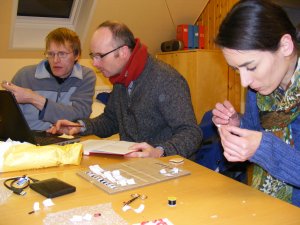
Funding
• Circadian Biology: from Field to Molecular Rhythms in Wild Birds, Elite Grant, Baden-Württemberg-Stiftung, 2012-14
Long-term timing: annual cycles, circannual clocks
Annual cycles of birds:
Most of my research so far has been dedicated to the study of seasonal timing and annual cycles of birds. Birds, like many other organisms, carry out a variety of seasonal activities each year, such as reproduction, moult and migration. For greatest success, these activities should be fitted to the change of the seasons, which often entails preparation far in advance. For example, in order to breed in spring, a long distance migrant often leaves the winter quarters many weeks ahead and reactivates its reproductive system on the way. To keep track of the seasons, birds can use the annual change in daylength (photoperiod) as an external calendar. But if kept under unchanging photoperiod, many avian species continue to show rhythmic cycles of reproductive capacity, migratory restlessness ("Zugunruhe") and moult. These cycles recur with period lengths of approximately one year and are therefore called "circannual rhythms". Continuing on from the seminal work of Ebo Gwinner, I have studied annual and circannual cycles in many body processes of birds. Most studies were carried out on a group of songbirds, Stonechats (Saxicola torquata), which in the wild breed under a wide range of environmental conditions within their extensive palearctic distribution range. We were able to show that these birds have geographically distinct, and heritable, timing programs. They differ in the ways they respond to photoperiod, but also in aspects of their endogenous circannual rhythm under unchanging daylengths. Current investigations of Stonechats compare aspects of physiology and life-history in populations from different environments. We also investigate whether different breeding schedules contribute to isolation and possibly speciation of local populations in Africa.
For details, see
- Helm, B. 2009. Geographically distinct reproductive schedules in a changing world: costly implications in captive Stonechats. Integrative and Comparative Biology, 49, 563-579.
- Helm, B., Schwabl, I. & Gwinner, E. 2009. Circannual basis of geographically distinct bird schedules. Journal of Experimental Biology, 212, 1259-1269.
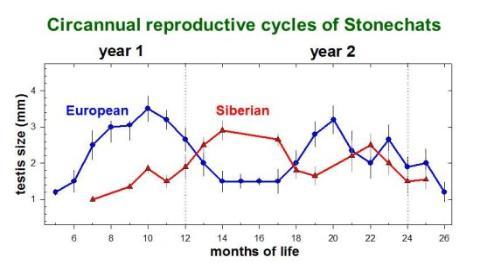 Circannual rhythms of reproductive activation in two populations of Stonechat. Siberian and European Stonechats were handraised and kept under identical conditions of unchanging photoperiod (Light:Dark 12:12 h). In both species, tesis size changed periodically. However, European short-distance migrants, which breed earlier in the year, had clearly earlier-phased reproductive cycles than did Siberian long-distance migrants.
Circannual rhythms of reproductive activation in two populations of Stonechat. Siberian and European Stonechats were handraised and kept under identical conditions of unchanging photoperiod (Light:Dark 12:12 h). In both species, tesis size changed periodically. However, European short-distance migrants, which breed earlier in the year, had clearly earlier-phased reproductive cycles than did Siberian long-distance migrants.
Seasons of Life
Phenology, the study of seasonally recurring biological processes, is of increasing importance in times of rapid global change. In many organisms seasonal patterns are changing, but we are only beginning to understand potential implications of such changes. Data from wild animals suggest that underlying circannual rhythms might limit the flexibility of an organism to respond to environmental change, at least in strongly programmed species. Clearly, integration of observational studies and chronobiological inquiry into underlying mechanisms is required for understanding – and potentially mitigating – effects of changing seasonality.
At the same time, medical and psychiatric studies suggest that annual cycles may be relevant even for our own health and well-being, despite the fact that humans shelter themselves to large extent from the change of seasons. Hence, consideration of Homo sapiens as principally a "seasonal animal" could enable a fresh look at medical and psychological problems. These developments emphasize a need for a better understanding of long-term timing mechanisms and the still enigmatic circannual clocks. Progress requires collaboration of researchers from disciplines that often do not interact. Together with Marcel Visser (Wageningen, The Netherlands), , and Russell Foster (Oxford), we have taken initiative to promote research on annual cycles. We will host a multi-disciplinary Symposium "Seasons of Life" in Glasgow, in November 2013, to foster cross-fertilization of ideas and collaborative research.
For background, see
- Helm, B., Ben-Shlomo, R., Sheriff, M.J., Hut, R.A., Foster, R., Barnes, B.M. & Dominoni, D. 2013. Annual rhythms that underlie phenology: biological time-keeping meets environmental change. Proceedings of the Royal Society of London Series B, in press.
- Visser, M., Schaper, S., van Oers, K., Caro, S. & Helm, B. 2010. Phenology, seasonal timing and circannual rhythms: towards a unified framework. Philosophical Transactions of the Royal Society of London Series B, 365, 3113-3127.
Evolutionary implications of circannual clocks?
Circannual reproductive cycles, like those found in Stonechats, could affect gene exchange between local populations due to allochrony. In earlier experiments with European and Siberian Stonechats, crossbred pairs suffered significantly reduced reproductive success that was largely explained by their different breeding schedules. Circannual rhythms are particularly robust in African Stonechats, where the birds breed annually under favourable seasonal conditions. Because seasonality in East Africa varies over short distance, we hypothesized that circannual rhythms of local populations could thereby impose reproductive barriers. This idea is investigated by Kim Mortega in her PhD project at the University of Konstanz. The project relates circannual clocks to possible initial steps towards speciation. Determining initial reproductive barriers and the ecological forces that shape them are crucial for understanding evolution because speciation involves reproductive isolation between diverging populations. Based on earlier, genetic indication of local divergence, the study tests allochronic isolation between Stonechat populations in the field in Kenya and Tanzania. Specifically, it uses the role of song in mate choice to study behavioural isolation and relates it to genetic divergence.
At the same study sites, Beate Apfelbeck, Ireene Madindou and Elizabeth Yohannes (Konstanz University, Germany) look at different aspects of physiology and ecology of the local Stonechat populations.
Fieldwork in East Africa: Kim Mortega and Ireene Madindou record songs of African Stonechats.
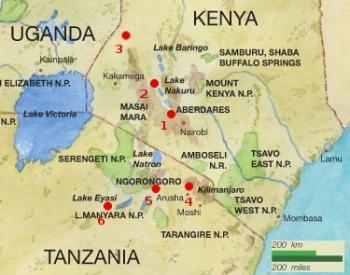 |
|
| Sites of comparative studies of Stonechats in East Africa (subject to modification during field work). |
Funding
- Allochronic diversification? Local seasonality as a driving factor for genetic and vocal divergence in an Afrotropical songbird, DFG (German Research Foundation) grant, 2011-14.
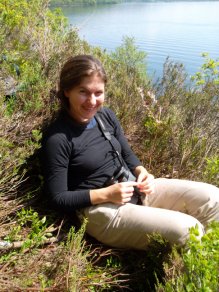
Funding
- Feodor-Lynen fellowship (Humboldt foundation) and host support (College of Medical, Veterinary and Life Sciences, University of Glasgow) to Bea Apfelbeck.
Migration and seasonally changing physiology
One of the most spectacular seasonal behaviours is the massive migration of birds – a phenomenon that has captivated human imagination and curiosity throughout recorded history. The eye-catching flight formations of avian migrants, for example Arctic geese that come to winter in Scotland, stand for a whole suite of behavioural, physiological and morphological specializations that have evolved in migratory birds. Together with many students and colleagues, we have studied various traits in association with migration biology. This work included morphological analyses of migratory traits in joint work with Maude Baldwin (Boston, USA) and in current follow-up studies with Katharina Foerster (Tuebingen, Germany) .
We have also investigated whether migratory habit is associated with differences in the immune system of birds, for example associated with susceptibility to avian influenza. Most recently, we have examined possible mechanisms by which birds navigate to their target areas in joint work with Richard Holland (Queens University, Belfast).
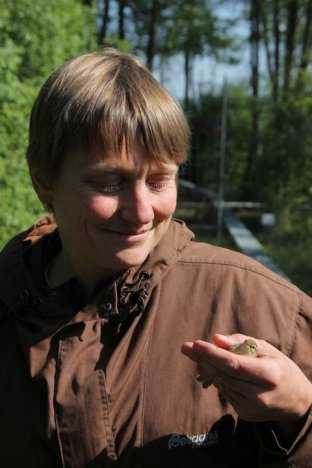
Field work on passage migrants at the German field station "Mettnau".
Most of our studies of migration are related to aspects of its timing. Because migration occurs typically in anticipation of seasonal change, an involvement of annual timing programs in its regulation had long been suspected and subsequently been rigorously shown. Moreover, in many species migration involves a shift from diurnal behaviour to temporary nocturnality during migratory flights in the wild, and during periods of migratory restlessness in captivity. Some of our studies of migratory timing have addressed mechanistic aspects, for example changes in plasma levels of the hormone melatonin. Most have used an annual-cycle approach to investigate changes in physiology and behaviour during migration season. In these studies, which were predominantly carried out on Stonechats, we studied migratory and non-migratory populations and compared whether these processes were modified across the annual cycle in similar ways. Ongoing work involves collaborative investigation of metabolic and immune traits with Maaike Versteegh, Irene Tieleman (Groningen University, The Netherlands) and Kirk Klasing (UC Davis, USA) . I also cooperate with Beate Apfelbeck (Tanzania) who examines the endocrine basis of life-history variation in Stonechats.
For details, see
- Kalthoff, D., Breithaupt, A., Helm, B., Teifke, J.P. & Beer, M. 2009. Migratory status is not related to the susceptibility to HPAIV H5N1 infection of Stonechats (Saxicola torquata). PLoS One, 4, e6170.
- Baldwin, M.W, Winkler, H., Organ, C.L. & Helm, B. 2010. Ecomorphological and evolutionary dynamics of morphology in Stonechats, Saxicola torquata, along a migratory gradient. Journal of Evolutionary Biology, 23, 1050-1063.
- Helm, B., Gwinner, E., Koolhaas, A., Battley, P., Schwabl, I., Dekinga, A., Piersma, T. 2012. Avian migration: Temporal multi-tasking and a case study of melatonin cycles in waders. Progress in Brain Research, 199, 457-479.
- Versteegh, M.A., Helm, B., Gwinner, E. & Tieleman, I.B. 2012. Annual cycles of metabolic rate are genetically determined but can be shifted by phenotypic flexibility. Journal of Experimental Biology, 215, 3459-3466.
- Holland, R.A. & Helm, B. 2013. A strong magnetic pulse affects the precision of departure direction of naturally migrating adult but not juvenile birds. Royal Society Interface, in press.
Funding
- Clocks on the move: Rescheduling body temperature for night flight?, Young Scholar Grant, DFG (German Research Foundation) and Konstanz University, 2012-2013
An enigmatic bird: The Bearded tit
In his PhD project "The factors affecting the bearded it, Panurus biarmicus, in the Tay Reedbeds, Scotland", Iain studies effects of changing climate and habitat management on a charismatic habitat specialist, the Bearded tit.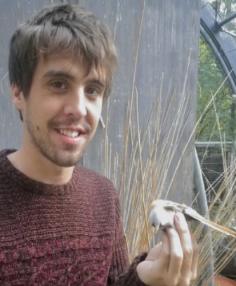 Iain Malzer, holding a Bearded tit
Iain Malzer, holding a Bearded tit
The Bearded tit, Panurus biarmicus, is a rare bird in Britain, with only 600 individuals nationwide. The largest breeding population in the UK inhabits the Tay Reedbeds in Scotland. This is an area of 410 hectares covered solely by common reed, Phragmites australis. The birds are highly dependent on this rare, inaccessible habitat, often spending their entire life within a single reedbed. Bearded tit populations in many reedbeds throughout Europe show conspicuous population fluctuations, with the Tay population demonstrating this trait clearly. To create a comprehensive and useful guide to the management and conservation of this species, the drivers of these fluctuations must be understood. This research will investigate the potential causes of population fluctuations by looking at the effects of management and climate on the health and distribution of the bearded tit population on the Tay. Extensive fieldwork using mist netting and bird ringing techniques for population analysis will be conducted. Further, the connectivity of bearded tit populations throughout Europe, and synchronicity of fluctuations between these populations will be analysed using mark-recapture techniques to statistically model extensive bearded tit ringing data.
Funding
- Carnegie Trust for the Universities of Scotland, Studentship for Iain Malzer.
Erling-Andechs: Cradle of Chronobiology
I was fortunate to have spent many years, up to its official closure and beyond, at the Max Planck Institute for Behavioural Physiology (later: Ornithology) in Erling-Andechs. At this institute in rural Bavaria, seminal chapters of chronobiology were written by Juergen Aschoff, Eberhard Gwinner, Ruettger Wever and many others. The heritage of this institute is immense, and much of the literature is now available online thanks to the "Chronohistory" initiative of the Society of Study of Biological Rhythms, or by request through barbara.helm@glasgow.ac.uk.
Eberhard Gwinner (1938-2004), the last director of Erling-Andechs, has synthesized biological rhythm research and ornithology in his rigorous research of migration, circannual and circadian biology. Ebo was a brilliant researcher, outstandingly kind person, inspiring PhD adviser, and - most of all - unforgotten friend.
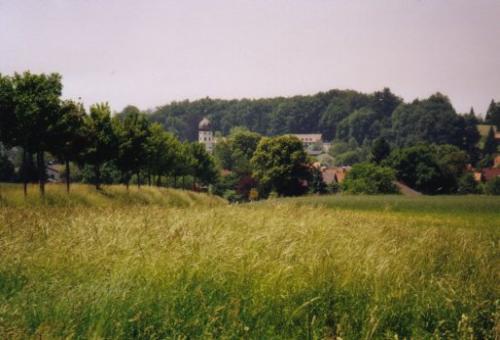
Former Max Planck Institute for Behavioural Physiology, located in the village of Erling-Andechs in Bavaria, Germany. Here, pioneers like Juergen Aschoff, Eberhard Gwinner and Ruettger Wever laid foundations of modern chronobiology.
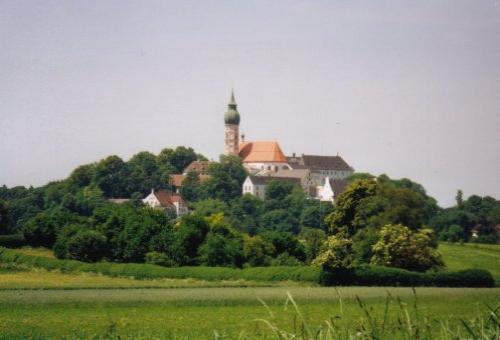
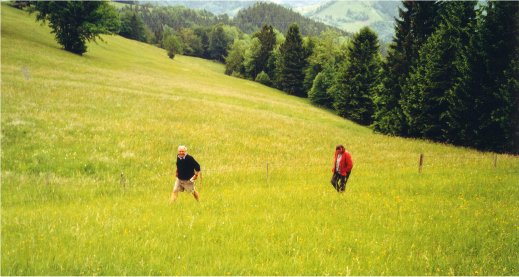
Ebo and Helga Gwinner in the mountains of Austria, 2003.
Grants
Grants and Awards listed are those received whilst working with the University of Glasgow.
- Effect of circadian disruption on telomere dynamics
Biotechnology and Biological Sciences Research Council
2017 - 2020
- Clocking the life of a nocturnal predator
The Royal Society
2017 - 2018
- Gene expression patterns in brains of great tits
European Research Council
2015 - 2016
- Environmental research for a changing world
Wellcome Trust
2014 - 2014
- Wildclocks
European Commission
2014 - 2017
- Gene expression and metabolomic phenotype in response to artificial light at night (ISSF STS)
Wellcome Trust
2013 - 2014
Additional information
Editorial Board
- 2007 - present: Journal of Avian Biology, Sweden - Science Editor
- 2006 - present: Journal of Avian Biology
- - present: Book (may not yet be in print) - Numata, H. & Helm, B. (eds.): Annual, Lunar and Tidal Clocks: Patterns and Mechanisms of Nature's Enigmatic Rhythms. Springer Japan, Tokyo
Grant Advisory Board
- 2009 - present: German Ornithological Society (DO-G) - Research Committee
- - present: European Cooperation in Science and Technology (COST) - Co-Chair, Management Committee and Working Group. Action 'Loss of the Night Network (LoNNe)'
Invited International Presentations
- 2013: Glasgow, UK (organizing) - Symposium, Seasons of Life: Biological Rhythms Underlying Healthy Living. (Conveners: B. Helm, Marcel Visser, Jane Robinson, Neil Evans and Russell Foster)
- 2013: Strasbourg, France - Under cover of darkness: nocturnal life of diurnal birds. International Workshop Understanding the neural basis of diurnality
- 2013: Munich, Germany - Circadian clocks and the real world: an avian perspective. The Gwinner Lecture. Plenary, 13th Biennial Meeting of the European Biological Rhythms Society.
- 2012: Ein Gedi, Israel - Night activity in diurnal birds: temporal programs and environmental regulation. International Workshop. The Diversity, Evolution and Mechanisms Controlling Activity Patterns. Rothschild Foundation
- 2012: Loch Lomond, UK (organizing) - Workshop, Approaches to investigating circannual and annual rhythms. (Conveners: B. Helm, Jane Robinson and Neil Evans)
- 2011: Kristineberg, Sweden - Reassessing circadian and circannual contributions to avian migration. Wenner-Gren-Foundations Symposium Animal Migration
- 2011: Oxford, UK - Temporal multi-tasking: Performance of migratory birds on different time scales. Keynote lecture, Symposium Enigmatic clocks: circannual and circatidal rhythms, 12th Biennial Meeting of the European Biological Rhythms Society
- 2010: Sandestin, Florida, USA - Circannual rhythms: organismal approaches to elusive periodic timers. Symposium Seasonal and Reproductive Rhythms, 12th Biennial Meeting of the Society for Research on Biological Rhythms
- 2009: Boston, Massachusetts, USA - Temporal coordination of life-cycle stages: an avian chronobiology perspective. Symposium Evolution of mechanisms controlling timing of breeding in animals, Annual meeting of the Society for Integrative and Comparative Biology
- 2009: Regensburg, Germany - Clocks, calendars, and seasonal modulations: time management of birds. Evening lecture upon receiving the Walther-Arndt award. Annual meeting of the German Zoological Society
- 2009: Zurich, Switzerland - Programs, cues, and flexibility: seasonal timing in birds. Plenary lecture, Biannual meeting of the European Ornithologists Union
- 2008: Israel - Multi-faceted association between migration, diet, and seasonal and circadian clock gene expression in birds (B. Helm & R. Ben-Shlomo). German-Israeli Year of Science and Technology, Tel Hai Academic College
- 2008: Portland, Oregon, USA - Tracking immuno-competence as a carry-over effect throughout the annual cycle (Kirk C. Klasing & B. Helm). Symposium: The physiological underpinnings of carry-over effects. Annual meeting of the American Ornithologists Union
- 2008: Leiden, the Netherlands - The road ahead. Outlook statement. Lorentz Center Life-Science Workshop Keeping track of the seasons: Ecological and physiological control of annual cycles of birds and mammals
Prizes, Awards and Distinctions
- 2012: Zoology and Behavioural Physiology, Konstanz, Germany - Habilitation, Venia Legendi
- 2010: Wolfgang-Pauli Institute (WPI) - Invited fellow
- 2010: Konstanz, Germany - Margarete von Wrangell Fellow
- 2009: German Zoological Society - Walther-Arndt Prize
- 2004: Max Planck Society - Otto-Hahn Medal
Professional Learned Society
- 2013 - present: British Ornithologists' Union (BOU)
- 2011 - present: Royal Institute for Navigation (RIN) - Associate Member
- 2009 - present: German Ornithological Society (DO-G) - Research Committee
- 2009 - present: European Biological Rhythms Society (EBRS)
- 2008 - present: German Zoological Society (DZG)
- 2008 - present: Society for Integrative and Comparative Biology (SICB)
- 2007 - present: Society for Research on Biological Rhythms (SRBR)
- 1982 - present: German Ornithological Society (DO-G)
- - present: Society for Research on Biological Rhythms (SRBR) - Member of Chronohistory Committee
Research Fellowship
- 2013 - present: WissenLeben - Scientific advisory board, NGO Science communication in the area of ecology and climate change
- - present: Scottish Centre for Ecology and the Natural Environment (SCENE) - Deputy Director, SCENE Field Station
- - present: RSPB and BTO - Invited advisor, Critically endangered species, Spoonbilled sandpiper taskforce
- - present: International Max Planck Research School (IMPRS) - Faculty and Board Member, International Max Planck Research School for Organismal Biology


